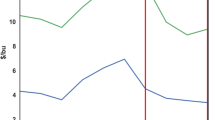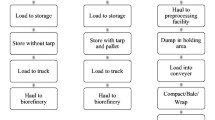Abstract
Production of switchgrass as a dedicated energy crop in the USA was proposed as a way to produce valuable products on millions of hectares that had been bid from traditional crop production by a variety of federal programs. The objective of the present study is to determine the expected economic consequences in terms of cost to deliver biomass feedstock, from restricting switchgrass production to marginal land for a case study region, when (a) land use is restricted to class IV; (b) land use is restricted to classes III and IV; and (c) use of land capability classes I, II, III, and IV is permitted. A hypothetical biorefinery with a processing capacity of 2000 Mg/day is assumed with switchgrass as the single biomass source. Soils and weather data were used in combination with crop management data to simulate switchgrass yields for each land capability class, for 50 years, for each of 30 Oklahoma counties. Land opportunity cost required to bid land from current use for each land capability class and each county were simulated based on the 2013 revealed county average Conservation Reserve Program (CRP) rental rates adjusted across capability class by relative productivity. A mathematical programming model was constructed and solved to determine the optimal quantity, location, and quality of the land leased. For the case study region, restricting land use to only capability class IV increases the land requirement by 44 % and increases the cost to deliver feedstock by 32 % compared to when switchgrass production is permitted on land classes I–IV.




Similar content being viewed by others
References
Lubowski RN, Vesterby M, Bucholtz S, Baez A, Roberts MJ (2006) Major uses of land in the United States, 2002. Economic Information Bull. 14. United States, Department of Agriculture, Economic Research Service
Hanson GD (1985) Financial analysis of a proposed large-scale ethanol cogeneration project. South J Agric Econ 17(02):67–76
United States Department of Agriculture FSA (2014) conservation programs. http://www.fsa.usda.gov/FSA/webapp?area=home&subject=copr&topic=rns-css Accessed December 18, 2014
McLaughlin S, Bouton J, Bransby D, Conger B, Ocumpaugh W, Parrish D, Taliaferro C, Vogel K, Wullschleger S (1999) Developing switchgrass as a bioenergy crop. In: Janick J (ed) Perspectives on New Crops and New Uses. ASHS Press, Alexandria, pp 282–299
Perlack RD, Wright LL, Turhollow AF, Graham RL, Stokes BJ, Erbach DC (2005) Biomass as feedstock for a bioenergy and bioproducts industry: the technical feasibility of a billion-ton annual supply. Oak Ridge National Laboratory http://www.dtic.mil/dtic/tr/fulltext/u2/a436753.pdf Accessed March 2, 2015
Pacheco M (2006) How biofuels can help reduce dependence on foreign oil. Statement prepared by National Renewable Energy Laboratory, National Bioenergy Center, for U.S. Senate Full Committee Hearing-Renewable Fuel Standards, 19 June, 2006
United States Congress (2007) Energy Independence and Security Act (EISA07). 110th U.S. Congress
Fargione J, Hill J, Tilman D, Polasky S, Hawthorne P (2008) Land clearing and the biofuel carbon debt. Science 319(5867):1235–1238
Searchinger T, Heimlich R, Houghton RA, Dong F, Elobeid A, Fabiosa J, Tokgoz S, Hayes D, Yu TH (2008) Use of U.S. croplands for biofuels increases greenhouse gases through emissions from land-use change. Science 319(5867):1238–1240
Broch A, Hoekman SK, Unnasch S (2013) A review of variability in indirect land use change assessment and modeling in biofuel policy. Env Sci Policy 29:147–157
Mapemba LD, Epplin FM, Taliaferro CM, Huhnke RL (2007) Biorefinery feedstock production on Conservation Reserve Program land. Appl Econ Perspect Policy 29(2):227–246
Gopalakrishnan G, Cristina Negri M, Snyder SW (2011) A novel framework to classify marginal land for sustainable biomass feedstock production. J Environ Qual 40(5):1593–1600
Kang S, Post WM, Nichols JA, Wang D, West TO, Bandaru V, Izaurralde RC (2013) Marginal lands: concept, assessment and management. J Agric Sci 5(5):129–139
Lewis SM, Kelly M (2014) Mapping the potential for biofuel production on marginal lands: differences in definitions, data and models across scales. ISPRS Int J Geo-Inf 3(2):430–459
Richards BK, Stoof CR, Cary IJ, Woodbury PB (2014) Reporting on marginal lands for bioenergy feedstock production: a modest proposal. BioEnergy Res 7(3):1060–1062
Ricardo D (1817) On the principles of political economy, and taxation. J. M. Dent & sons, Ltd, London
Grieve RH (2012) The marginal productivity theory of the price of capital: an historical perspective on the origins of the codswallop. Real-World Econ Rev 60:139–149
Peterson GM, Galbraith J (1932) The concept of marginal land. J Farm Econ 14(2):295–310
Bibby JS, Mackney D (1969) Land use capability classification. Soil survey technical monograph No. 1. Rothamsted Experimental Station Harpenden
Larson G, Roloff G, Larson W (1988) A new approach to marginal agricultural land classification. J Soil Water Conserv 43(1):103–106
Norton EA (1939) Soil conservation survey handbook. 352. U.S. Department of Agriculture, Miscellaneous Publication No. 352, Washington
United States Department of Agriculture, Soil Conservation Service (1961) Land capability classification. Agricultural Handbook Number 210. http://www.nrcs.usda.gov/Internet/FSE_DOCUMENTS/nrcs142p2_052290.pdf Accessed August 12, 2014
United States Environmental Protection Agency (2010) Renewable Fuel Standard Program (RFS2) Regulatory impact analysis. http://www.epa.gov/otaq/renewablefuels/420r10006.pdf Accessed March 14, 2014
Isik M, Yang W (2004) An analysis of the effects of uncertainty and irreversibility on farmer participation in the Conservation Reserve Program. J Agric Resour Econ 242–259
Hellerstein DR, Malcolm SA (2011) The influence of rising commodity prices on the Conservation Reserve Program. U.S. Department of Agriculture, Economic Research Service, Report Number 110. http://ers.usda.gov/publications/err-economic-research-report/err110.aspx Accessed January 14, 2015
United States Department of Agriculture, Soil Service Geographic (SSURGO) (2014) Database for Oklahoma. http://websoilsurvey.sc.egov.usda.gov/App/HomePage.htm/. Accessed August 8, 2014
United States Department of Agriculture, Economic Research Service (2015) Commodity costs and returns. http://www.ers.usda.gov/data-products/commodity-costs-and-returns.aspx Accessed March, 18, 2015
Jensen K, Clark CD, Ellis P, English B, Menard J, Walsh M, de la Torre Ugarte D (2007) Farmer willingness to grow switchgrass for energy production. Biomass Bioenergy 31(11):773–781
Bergtold JS, Fewell J, Williams J (2014) Farmers’ willingness to produce alternative cellulosic biofuel feedstocks under contract in Kansas using stated choice experiments. BioEnergy Res 7(3):876–884
Wang C (2009) Economic analysis of delivering switchgrass to a biorefinery from both the farmers’ and processor’s perspectives. Master’s Thesis, University of Tennessee, Knoxville
United States Energy Information Administration (2015) Petroleum and other liquids outlook. http://www.eia.gov/dnav/pet/hist/LeafHandler.ashx?n=pet&s=emd_epd2d_pte_nus_dpg&f=a Accessed March 4, 2015
Oklahoma Climatological Survey. Oklahoma Mesonet (2014) Daily weather data. http://cig.mesonet.org/∼gmcmanus/freeze/freeze.html/ Accessed August 16, 2014
National Oceanic and Atmospheric Administration (2014) Daily weather data for Oklahoma. http://gis.ncdc.noaa.gov/map/viewer/#app=clim&cfg=cdo&theme=daily&layers=0001&node=gis Accessed August 16, 2014
Egbendewe-Mondzozo A, Swinton SM, Izaurralde CR, Manowitz DH, Zhang X (2011) Biomass supply from alternative cellulosic crops and crop residues: a spatially explicit bioeconomic modeling approach. Biomass Bioenergy 35(11):4636–4647
Debnath D, Epplin FM, Stoecker AL (2014) Managing spatial and temporal switchgrass biomass yield variability. BioEnergy Res 7(3):946–957
Wright L, Turhollow A (2010) Switchgrass selection as a “model” bioenergy crop: A history of the process. Biomass Bioenergy 34(6):851–868
Turhollow A, Epplin F (2012) Estimating region specific costs to produce and deliver switchgrass. In: Monti A (ed) Switchgrass: A valuable biomass crop for energy. Springer, New York, pp 187–203
Brechbill SC, Tyner WE, Ileleji KE (2011) The economics of biomass collection and transportation and its supply to Indiana cellulosic and electric utility facilities. BioEnergy Res 4(2):141–152
Zhang P, Zhang Q, Pei Z, Wang D (2013) Cost estimates of cellulosic ethanol production: a review. J Manuf Sci Eng 135(2):021005
Haque M, Epplin FM (2012) Cost to produce switchgrass and cost to produce ethanol from switchgrass for several levels of biorefinery investment cost and biomass to ethanol conversion rates. Biomass Bioenergy 46:517–530
Epplin FM (1996) Cost to produce and deliver switchgrass biomass to an ethanol-conversion facility in the southern plains of the United States. Biomass Bioenergy 11(6):459–467
Duffy M (2007) Estimated costs for production, storage, and transportation of switchgrass. Department of Economics, Iowa State University, Ames
Epplin FM, Clark CD, Roberts RK, Hwang S (2007) Challenges to the development of a dedicated energy crop. Am J Agric Econ 89(5):1296–1302
Khanna M, Dhungana B, Clifton-Brown J (2008) Costs of producing miscanthus and switchgrass for bioenergy in Illinois. Biomass Bioenergy 32(6):482–493
Mapemba LD, Epplin FM, Huhnke RL, Taliaferro CM (2008) Herbaceous plant biomass harvest and delivery cost with harvest segmented by month and number of harvest machines endogenously determined. Biomass Bioenergy 32(11):1016–1027
Kazi FK, Fortman J, Anex R, Hsu D, Aden A, Dutta A, Kothandaraman G (2010) Techno-economic comparison of process technologies for biochemical ethanol production from corn stover. Fuel 89:S20–S28
United States Department of Energy (2011) U.S. Billion-Ton Update: biomass supply for a bioenergy and bioproducts industry. Perlack RD and Stokes BJ (Leads), ORNL/TM-2011/224. Oak Ridge National Laboratory
Bryngelsson DK, Lindgren K (2013) Why large-scale bioenergy production on marginal land is unfeasible: a conceptual partial equilibrium analysis. Energy Policy 55:454–466
Gelfand I, Sahajpal R, Zhang X, Izaurralde RC, Gross KL, Robertson GP (2013) Sustainable bioenergy production from marginal lands in the U.S. Midwest. Nature 493(7433):514–517
Liu T, McConkey B, Ma Z, Liu Z, Li X, Cheng L (2011) Strengths, weaknesses, opportunities and threats analysis of bioenergy production on marginal land. Energy Procedia 5:2378–2386
Acknowledgements
Funding was provided by the USDA-NIFA, USDA-DOE Biomass Research and Development Initiative, Grant No. 2009-10006-06070, by the Jean & Patsy Neustadt Chair, by the USDA National Institute of Food and Agriculture, Hatch grant number H-2824, and by the Oklahoma Agricultural Experiment Station. Support does not constitute an endorsement of the views expressed in the paper by the USDA.
Author information
Authors and Affiliations
Corresponding author
Rights and permissions
About this article
Cite this article
Gouzaye, A., Epplin, F.M. Restricting Second-Generation Energy Crop Production to Marginal Land. Bioenerg. Res. 9, 257–269 (2016). https://doi.org/10.1007/s12155-015-9689-8
Published:
Issue Date:
DOI: https://doi.org/10.1007/s12155-015-9689-8




